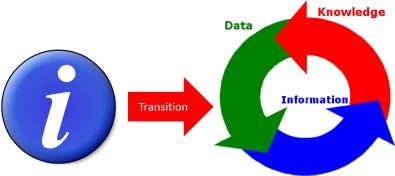A new clause on Organizational knowledge was introduced into ISO 9001:2015 which was not included in Annex SL. It recognizes that knowledge is a resource and vital to success and therefore it’s important to ensure there is sufficient supply of it.
What is organizational knowledge?
The term organizational knowledge is not defined in 9000 but in Note 1 to the requirement it is explained as being "knowledge specific to the organization and is gained by experience. It is information that is used and shared to achieve the organization's objectives”.
How does knowledge differ from information?
Information consists of processed data with the processing being directed at increasing its usefulness. It answers questions with such words as who, what, where, when and how many.
Knowledge results from analysing the relationship between various pieces of information and is conveyed by answers to 'how-to' questions. It allows us to describe things. Knowledge proceeds from parts to the whole i.e. from using information to explain what a part is, knowledge confers an ability to explain how to modify, repair, replace or do something else with the part, and what affects it has on the whole if its modified, removed or caused to malfunction etc.
Types of knowledge
There are different types of knowledge:
Explicit knowledge is the knowledge captured or codified in a tangible form, in what ISO 9000 refers to as documented information
Tacit knowledge is "knowledge that inhabits the mind of the individual" (Polanyi, 2009). Its: know-how, know-what, know when it's the right time, know-who and know where to; knowledge gleaned from experience and knowledge that is difficult to articulate.
Implicit knowledge is the knowledge that is not made explicit but could be.
Embedded knowledge is locked in the organization's processes, products, services, culture, routines, artefacts, or structures.
The knowledge possessed by an individual will be a combination of the above. Some of it will have been gleaned from reading (explicit knowledge), some of it by learning on the job (tacit and implicit knowledge), some of it by socialising in the workplace (embedded knowledge).
Moving from information to knowledge
Previous version of ISO 9001 have focused on documenting information but from the above it will be observed that this only covers explicit knowledge. It will also be observed that it’s not practical or even feasible to attempt to covert all knowledge into explicit knowledge.
When planning to achieve an objective, its intuitive to ask: What do I need to know? To get the answer it is likely that you will firstly access your memory and retrieve all you think is relevant. The paradigm you hold will drive you in a certain direction in search of the knowledge to want. You'll then gather together the explicit knowledge you are aware of and if necessary form a group of people each possessing knowledge you need to work out how to achieve the objective and what you need to know. These people may not share your paradigm and so bring in different and possibly opposing knowledge. In bringing these people together you have determined the type of knowledge you need. They share their knowledge; you consult the explicit knowledge and in so doing you can prepare a plan of action which conveys knowledge to those who will implement the plan. They are assigned to achieve the objective and retrieve the plan which determines the explicit knowledge they need. The rest is up to them using their tacit knowledge to repeat the process.
When planning a process, product or service you'll encounter situations where the knowledge you need is not contained in the organization and either you search for explicit knowledge or you search for someone with the appropriate tacit knowledge i.e. the know-how.
More details are in Chapter 28 of the ISO 9000 Quality Systems Handbook 7E
